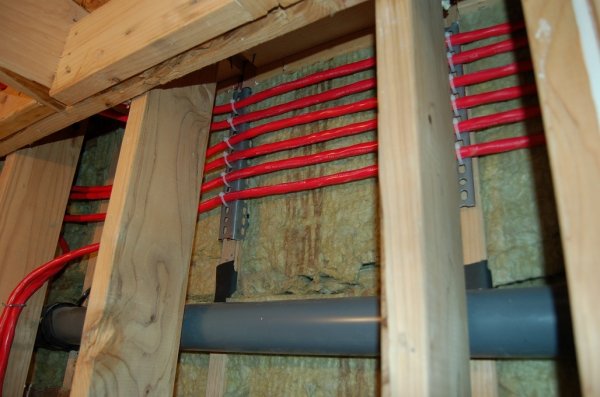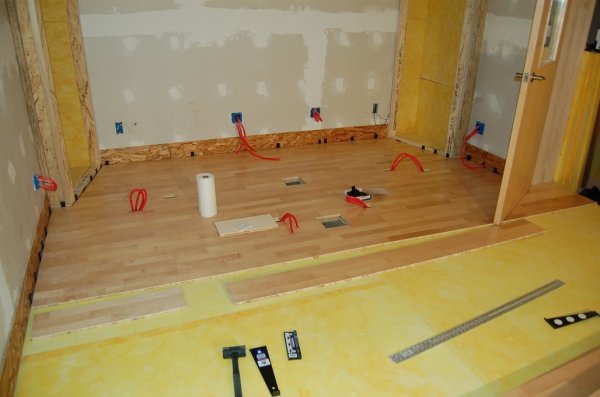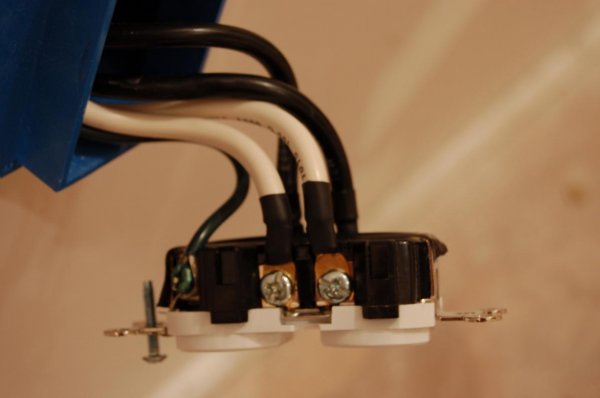Recommendation of in wall AC cable
- Thread starter adyc
- Start date
You are using an out of date browser. It may not display this or other websites correctly.
You should upgrade or use an alternative browser.
You should upgrade or use an alternative browser.
Oyaide all the way.
I used 105m for 6 dedicated lines, and two short runs consumer unit to balanced transformer and back again.
I used 105m for 6 dedicated lines, and two short runs consumer unit to balanced transformer and back again.
The first question is: where are you located? as different jurisdictions have different rules.
Are you planning on using SouthWire Romex® or other UL listed (NM) non-metallic cable?
Or is it metal or plastic conduit (tubing) ridged or flexible.
Now most hi-fi systems should be on a single 120V, 20 A circuit.
But if it's a very large system that needs more power, I would run a large 120V feeder from the main breaker panel to a small breaker box in/near the audio room.
The idea is to reduce the length of AC cables from hi-fi component to component.
Are you planning on using SouthWire Romex® or other UL listed (NM) non-metallic cable?
Or is it metal or plastic conduit (tubing) ridged or flexible.
Now most hi-fi systems should be on a single 120V, 20 A circuit.
But if it's a very large system that needs more power, I would run a large 120V feeder from the main breaker panel to a small breaker box in/near the audio room.
The idea is to reduce the length of AC cables from hi-fi component to component.
I am going to run some AC wires from my breaker panel to my Hi-Fi rig. Any recommendation of good AC wire?
[FONT="]The A/V electronics are served by a dedicated 100A electrical sub-panel with (4) 20A circuits. Twisted pair wiring (#12) is used for each circuit with the neutral and hot wires wrapped on 2" centers and the ground wire placed parallel in PVC conduit. A paper presented at the 2010 AES 129th Convention shows this method has the lowest ground voltage induction tested.[/FONT]
If it's a longer run definitely go with a sub-panel as close to the system as possible and run 10g wire from there.
If you're running multiple lines I'd consider using power distribution from each line with a ground post on it and combine the grounds from all lines using these ground posts. The idea is to lower resistance as much as possible between component grounds. This will absolutely increase sound quality by lowering noise.
If you're running multiple lines I'd consider using power distribution from each line with a ground post on it and combine the grounds from all lines using these ground posts. The idea is to lower resistance as much as possible between component grounds. This will absolutely increase sound quality by lowering noise.
Yes, but it doesn't need to be a sub-panel, it can be a simple 6 breaker box.If it's a longer run definitely go with a sub-panel as close to the system as possible and run 10g wire from there.
Exactly!The idea is to lower resistance as much as possible between component grounds. This will absolutely increase sound quality by lowering noise.
Now most hi-fi systems should be on a single 120V, 20 A circuit.
But if it's a very large system that needs more power, I would run a large 120V feeder from the main breaker panel to a small breaker box in/near the audio room.
The idea is to reduce the length of AC cables from hi-fi component to component.
If the Hi-Fi system in a single circuit, what power strip would you recommend?
Thanks guys for all suggestions. It is going to be a short run around 5m. Further question, will unequal length of in wall cables cause ground noise?
5m I wouldn't run a sub-panel but it's long enough that if you run multiple lines the grounds should be combined as I described above. If your system doesn't need more than a single line that simplifies things and makes problems with noise less likely. It just depends if you have monster amps or not. Unequal length lines won't matter but I'd run them together as far as you can as separated multiple lines can potentially form ground loops.
The best power distribution depends on your budget... a fully featured (surge and emi/rfi filters) 20A Torus is what I'd choose cost-no-object. One of my modded SurgeX devices is probably the best you'll find under a few grand (they run $1-2k) but I might be a bit biased on that!
Sorry, I don't have access to any of the now available models, to open up and examine.If the Hi-Fi system in a single circuit, what power strip would you recommend?
a] I don't know just where the equal length power line idea came from, but engineer's that should know better repeated it.
b] Yes, run a the power cables on the same path, close to each other.
c] Examine the breaker box (panel board) and make sure that all the hi-fi circuits are on the same pole/leg (aka phase).
d] SurgeX's are great but very expensive. For most people a whole home surge protector near the main breaker box is all you need.
b] Yes, run a the power cables on the same path, close to each other.
c] Examine the breaker box (panel board) and make sure that all the hi-fi circuits are on the same pole/leg (aka phase).
d] SurgeX's are great but very expensive. For most people a whole home surge protector near the main breaker box is all you need.
a] I don't know just where the equal length power line idea came from, but engineer's that should know better repeated it.
b] Yes, run a the power cables on the same path, close to each other.
c] Examine the breaker box (panel board) and make sure that all the hi-fi circuits are on the same pole/leg (aka phase).
d] SurgeX's are great but very expensive. For most people a whole home surge protector near the main breaker box is all you need.
d isn't true. Surges most often come from within the home, and the emi/rfi filter in the SurgeX is a benefit, moreso the noisier the AC power is. In every situation I've tried or heard about it will provide some improvement, sometimes a very large improvement.
Seldom do Dave and I agree on even 3 out of 4 points.
Going back to point [d] MOV point of use surge protectors are not a good idea.
Going back to point [d] MOV point of use surge protectors are not a good idea.
Seldom do Dave and I agree on even 3 out of 4 points.
Going back to point [d] MOV point of use surge protectors are not a good idea.
For an audio system, yes... for a cheap power strip for other things maybe. I hate throw-away devices (power strips w/MOVs fail eventually) but I can't afford a SurgeX type device for everything.
And it should be pointed out SurgeX is NOT a MOV type device and isn't sacrificial so it will not be destroyed by surges eventually. It's also not noisy or current-limiting, you can plug big amps into a SurgeX with no degradation of performance, in fact the opposite.
Hello,
Regarding point a. above. The lengths of the various runs need to be the same so that the ground impendance of each leg is the same. If the impedance are different you will create a ground loop and get nasty hum. I fell into this trap and paid dearly for it. So each "in-wall" line needs to be the same length. You can snake the extra back and forth in the attic or wall or whatever. Do not coil it up or you will create a lot of inductance in the line.
Regarding point a. above. The lengths of the various runs need to be the same so that the ground impendance of each leg is the same. If the impedance are different you will create a ground loop and get nasty hum. I fell into this trap and paid dearly for it. So each "in-wall" line needs to be the same length. You can snake the extra back and forth in the attic or wall or whatever. Do not coil it up or you will create a lot of inductance in the line.
Hello,
Regarding point a. above. The lengths of the various runs need to be the same so that the ground impendance of each leg is the same. If the impedance are different you will create a ground loop and get nasty hum. I fell into this trap and paid dearly for it. So each "in-wall" line needs to be the same length. You can snake the extra back and forth in the attic or wall or whatever. Do not coil it up or you will create a lot of inductance in the line.
The issue you had was probably due to loop area, if this doesn't exist then ground loops won't form due to a magnetic field within that loop. Further, it's best to combine all grounds as close to the system as possible, and not all the way back at the panel.
Also, a coil consisting of both legs won't form an inductor, if it was only one leg of the circuit then yes, it would form an inductor.
Hello,
Regarding point a. above. The lengths of the various runs need to be the same so that the ground impendance of each leg is the same. If the impedance are different you will create a ground loop and get nasty hum. I fell into this trap and paid dearly for it. So each "in-wall" line needs to be the same length. You can snake the extra back and forth in the attic or wall or whatever. Do not coil it up or you will create a lot of inductance in the line.
This was the incorrect thinking of those people that should have known better.
But I don't have time now to get into it.
So let's go with Dave's correct short answer:
Further, it's best to combine all grounds as close to the system as possible, and not all the way back at the panel.
Dave, you seem to know quite a bit on the subject. I agree that two parallel wires wound to make a solenoid carrying the same current but in opposite directions has an inductance of zero. Have you considered what happens when the return current is out of phase with the input current as will most definitely be the case on the output of an amplifier. The time averaged magnetic field will still be zero but within any given cycle there will definitely be inductance because at any instant in time the two magnetic fields don't cancel each other.
Similar threads
- Replies
- 8
- Views
- 863
- Replies
- 936
- Views
- 47K
- Replies
- 0
- Views
- 595
- Replies
- 1
- Views
- 1K
Members online
- Azh123
- gilles13
- MRJAZZ
- Mark212121
- 2ndLiner
- leyenda
- Danager
- Husk
- dminches
- iain
- rau
- Myles1972
- takacs75
- orrman
- Casasky
- nkjtbushwood
- amadeus
- jbazz
- Geoffkait
- lem321
- andromedaaudio
- tsaett
- tailspn
- hopkins
- George47
- ticktock
- morricab
- Kal Rubinson
- hesavary
- Tuckia
- 3rdRock
- arthurs
- wokeuptobose
- AlbertD
- c_ocobean1
- UncleE
- trekpilot
- Blake
- marty
- bonzo75
- iaxel
- Foxbat
- Folsom
- Joe Whip
- JeremyMTB
- wbass
- findog
- LarryK
- RickS
- s_c
Total: 1,734 (members: 75, guests: 1,659)
| Steve Williams Site Founder | Site Owner | Administrator | Ron Resnick Site Co-Owner | Administrator | Julian (The Fixer) Website Build | Marketing Managersing |



















